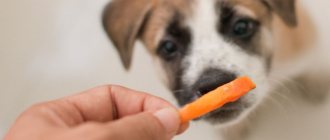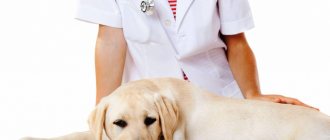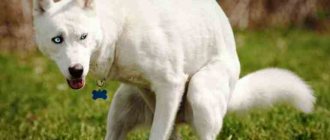Causes of colds
Most often, puppies and older dogs, as well as exhausted or overtired animals with weakened immunity for some reason, are susceptible to colds.
If your pet has a strong immune system, is kept in comfortable conditions, and receives a sufficient amount of vitamins, minerals and other useful substances, then most likely you will not even notice that your dog has a cold.
The dog’s strong body will cope with the disease on its own in just a couple of days. The only sign of a cold in an animal in good health may be subtle lethargy and poor appetite.
However, if the dog has a weak immune system and poor heredity, the disease can take more severe forms. Next, let's look at the factors that can trigger a cold.
Diet disorder
No matter how trivial it may sound, nutrition is one of the main causes of disease.
An unbalanced, incorrect diet, lack of vitamins, minerals and other nutrients can lead to a malfunction of the immune system. Immunity decreases, and, as a result, the dog’s body’s resistance to various microbes deteriorates.
And I know this firsthand. When our Jack was still a puppy, we chose the wrong type of food for him. Wanting to reduce the time spent preparing food, we fed him dry food. Despite the fact that we tried a lot of premium foods, Jack’s body flatly refused to accept any of them. No, Jack, of course, did not catch a cold, but against the background of a decrease in immunity, skin sores began to “stick” to him. But as soon as we switched him to natural food and balanced his daily feeding ration, Juzi quickly began to recover, and together we dealt with all his ailments.
Hypothermia
In most cases, colds in dogs can occur due to hypothermia during long walks in the cold or in the rain.
It is especially dangerous to go outside with your dog in the cold season immediately after swimming. Even a small draft in this case can lead to hypothermia and a cold.
In order for your pet’s immunity to be strong and the body’s thermoregulation to always be normal, it is necessary to harden the dog from childhood, teaching it to walk at low temperatures.
What dangers can await animals, and what every owner of a four-legged animal needs to know in order to protect their furry friend in the cold season, you can read in the article: Dog in winter.
Dogs of small breeds have a higher body temperature than their relatives with a large weight category, so the danger of hypothermia for furry babies is especially great.
Heredity and popularity of the breed
Yes, yes, that's not a typo. If everything is more or less clear with heredity, then the popularity of the breed affects both the health of the pet and its life expectancy.
In pursuit of profit, some unscrupulous breeders do not take care of both the parents, constantly carrying out matings that wear out the animal’s body, and the puppies, without paying attention to the quality and health of the litter. All this directly affects the immune system. It is weakened and the body is more vulnerable and prone to pathological and colds.
Age
With age, older dogs experience a deterioration in the functioning of the main body systems, a decrease in immunity and the ability to fight various infections.
Therefore, older animals require more careful treatment and care.
Sedentary lifestyle
A sedentary lifestyle reduces the body's resistance to various diseases. Active long walks strengthen the immune system, promote health and physical strength.
Violation of maintenance standards
Damp and cold rooms, drafts, lack of preventive medical therapy - all this ultimately leads to the occurrence of diseases, including colds.
To prevent colds in dogs, provide the animal with a warm and dry place to sleep and a complete and proper diet.
Do not arrange your sleeping area in a draft or near heating devices. Dry your pet thoroughly after bathing and send him to dry in a warm room with the windows closed.
Contact with a sick animal
If your pet plays with an already sick dog during a walk, then the likelihood of contracting not only a cold, but also other infectious diseases and parasites is very high.
Fleas, worms, ticks and other parasites
Fleas, worms, ticks and other parasites significantly weaken the immune system. They are carriers of dangerous infections. Actively multiplying, they oppress and weaken the body. A weak body is susceptible to various diseases and cannot fight them on its own.
Is it possible?
Veterinarians often prescribe this drug to dogs, because under its action the body stimulates the production of its own interferon, which protects the animal from viruses.
Cycloferon also has other beneficial effects:
- eliminates inflammatory processes;
- improves the functioning of the immune system;
- stimulates the production of bone marrow stem cells;
- inhibits tissue proliferation and reduces the growth of tumors.
Symptoms
Many cold symptoms can be signs of a more serious illness in the animal. Successful treatment in most cases directly depends on a correct diagnosis.
Hot and dry nose
Your pet's hot, dry nose is the first sign that your pet needs to be examined. But a dry nose is not always a sign that the dog is sick.
In most cases, a warm and dry nose is only a temporary phenomenon associated with physiological reasons. You can read in more detail about situations when a dry nose in your pet is not a cause for concern in the article: When a dry nose in a dog is normal.
If your pet has a hot and dry nose, but otherwise feels fine, then there is no need to worry.
But if your pet has a warm nose and shows other signs of discomfort, then this is an alarming signal.
Increased body temperature
If your dog has a hot nose and you observe other symptoms of illness, the first thing you need to do is measure the animal's body temperature.
A dog's body temperature varies depending on the age, weight and breed of the four-legged dog. Every dog owner needs to know what the normal body temperature of his pet should be, and how to measure it correctly at home if his four-legged friend is unwell.
On average, the body temperature of an adult animal ranges from 37.5 to 39 degrees.
Behavior change
As a rule, a cold is accompanied by changes in the dog’s usual behavior. The dog becomes lethargic, sleeps a lot, gets tired quickly, refuses to eat, and does not want to play.
Discharge from nose and eyes
A runny nose and watery eyes are characteristic signs of the onset of a cold. But in case of a viral infection, the discharge should be clean and transparent, without any impurities (pus, blood, foam...).
Impurities in the discharge indicate a more serious disease.
Cough and sneeze
Sneezing and coughing during a cold should also be free of foreign impurities. Just as in the case of a runny nose, when sneezing, the animal’s face should be clean, and crusts should not form from the discharge.
A persistent cough is much more serious. A cough may indicate complications (bronchopulmonary diseases).
Fever, fever and shaking
When the body temperature rises, the dog begins to shiver. She is shaking and trying to find a source of warmth. This symptom indicates that the disease is in the acute phase. In this case, you cannot self-medicate. You need to urgently contact a specialist.
Dulling of wool
Dull and unkempt fur is one of the signs of a cold.
All of the above symptoms are not always evidence of a cold in a dog. A viral infection has clear and at the same time vague symptoms that may indicate a more serious illness. Therefore, you should not try to diagnose yourself.
Monitor your pet's condition and the progress of the disease as closely as possible. Remember where your pet has been lately, whether he was lying in the snow or in a draft, or whether he ate snow outside. All this will help determine the diagnosis.
Indications in veterinary medicine
Most often, veterinarians prescribe Cycloferon for viral infections in dogs. The main indications are:
- distemper (distemper of carnivorous animals);
- coronavirus and parvovirus enteritis;
- viral papillomatosis (most often papillomas appear in the mouth area);
- laryngotracheitis (inflammation of the larynx and trachea);
- conjunctivitis (inflammation of the mucous membrane of the eyes);
- hepatitis of various origins;
- colds.
The drug is prescribed after surgical operations (including during castration) as a means that can fight inflammation and improve the condition of the dog’s immune system.
Due to its immunomodulatory properties, Cycloferon is indicated for malignant tumors. The drug inhibits the growth of tumors.
If the dog gets sick during estrus, then Cycloferon should be used only as prescribed by a doctor and under his supervision.
It is not recommended to use Cycloferon in the treatment of pregnant and lactating dogs. In rare cases, the drug can be prescribed to puppies, but treatment should be under the supervision of a veterinarian. The doctor selects the individual dosage, duration of therapy and dosage form of the medication.
First aid
We will not talk about drug treatment for colds in dogs. Making a diagnosis and prescribing treatment should only be entrusted to a qualified specialist. Let's talk about first aid for an animal.
If you notice all of the above symptoms in your dog, then most likely your pet has a cold. And you need to know a few basic rules of first aid:
- First of all, provide your dog with rest, a sufficient amount of clean, fresh and warm water, and a fortified diet. If your dog refuses to eat, try giving him warm meat broth.
- The room where the animal is located must be warm and dry. Eliminate possible drafts.
- Cover your sleeping area with a down scarf or any fabric that can retain heat for a long time. If the dog is shaking or freezing, place a heating pad or a plastic bottle with warm water or a bag of heated salt in the bed.
- A regular massage will help your dog warm up very well. It accelerates blood in the vessels and tones the body.
- Remove discharge from the nose and eyes with a damp sponge. If your eyes and nose become dry, you can use special moisturizing drops.
- Limit the duration of your walks, especially in the cooler months. To prevent your pet from getting too cold, put on a warm jumpsuit.
Composition and expiration date
The active ingredient of the drug is meglumine acridone acetate. Additionally, the solution contains water for injection. Excipients of tablets are povidone, calcium stearate, polysorbate, etc., liniment is propylene glycol and benzalkonium chloride.
Cycloferon must be stored at room temperature, protected from sunlight and daylight. The shelf life of tablets and liniment is 2 years from the release date indicated on the package, the solution is 3 years.
Consequences of a cold
Any body exposed to a cold begins to resist the disease. This is accompanied by fever, sneezing, coughing and other previously listed symptoms. And, if treatment is not started in time, then a simple mild ailment can develop into a more serious disease: pneumonia, rheumatism, kidney disease, cystitis, and so on.
Frequent colds significantly reduce immunity and make the dog easily susceptible to various infections.
To ensure your pet good health and stable immunity, it is important to strengthen the body’s thermoregulatory system from childhood and harden the four-legged animal.
Side effects
During treatment, side effects are rare. They are weakly expressed:
- tablets and solution for injection - short-lived weakness, diarrhea, nausea;
- liniment - a short-term burning sensation at the site of application of the medicinal composition, redness of the skin.
Most often, unpleasant symptoms appear in those dogs whose body does not tolerate any substance that is part of Cycloferon. A similar thing is observed with an overdose. This condition passes quite quickly.
Prevention
Very often, when getting a small fluffy puppy, trying to protect this tiny creature from the slightest influence of the external environment, the owners begin to “shake” over it: wrap it in warm clothes at the slightest drop in temperature. Thus, while trying to help their pet, animal owners not only do not help them, but rather even harm them.
The body of a pampered animal loses the ability to independently fight natural influences: wind, rain, cold. The body's thermoregulation is disrupted, and the pet gets sick from the slightest breath of wind.
It is very important to accustom your dog to exposure to adverse weather conditions from childhood. And the easiest way is hardening. Of course, it is also worth hardening within reasonable limits. You shouldn’t immediately take your puppy out into the cold and wait until he gets used to it.
It is necessary to gradually, repeatedly, constantly increasing the time the animal spends in the cold, accustom it.
Also, hardening should take place against the background of a nutritious and satisfying diet.
You can read some useful tips on how to protect your dog during the cold months in the article: How to care for your dog in winter.
Instructions for use
Veterinarians recommend this dosage form if it is not possible to give injections.
The advantage of tablets is that the dog owner does not require special knowledge, as is the case with injections. You can give the tablets in 2 ways: by mixing with food or dissolving in water and pouring the liquid into the pet’s mouth.
The daily dosage is calculated by the veterinarian. The specialist takes into account not only the dog’s weight, but the stage of development of the disease, existing chronic diseases and other factors. The duration of therapy is also determined by the doctor. Self-medication often leads to negative consequences.
If necessary, to obtain a faster and more effective effect, injections are given. The dosage is calculated per 1 kg of animal body weight:
- up to 3 kg (dwarf breeds) – 0.4 ml;
- from 3 to 5 kg – 0.2 ml;
- from 5 to 12 kg – 0.15 ml;
- from 12 to 25 kg – 0.12 ml;
- from 25 to 40 kg – 0.1 ml;
- over 40 kg – 0.8 ml.
Injections are administered subcutaneously or intramuscularly according to the scheme - 2 days in a row, then every other day - 4, 6, 8 days. It is better to stab at the withers, unless the veterinarian recommends another place.
If the disease is acute, intravenous injections may be prescribed. But only a doctor can do them. The medicine is combined with globulins, serums, interferon.
Liniment is good because it is used externally. The medicinal composition should be applied in a thin layer to the area of skin affected by the disease. The procedure is repeated in the morning and evening. A small amount of ointment is enough for 1 time - about the size of a pea.
The disadvantage of liniment is that the dog will try to lick the ointment, so you need to use a special veterinary collar.
Analogs
Cycloferon has no complete analogues. But if necessary, veterinarians can replace it with the following drugs:
- Interferon is an antiviral and immunomodulatory agent. Available in the form of a solution for injection. The advantage of this drug compared to Cycloferon is its low cost - from 80 rubles. The medication is not available in other dosage forms.
- Fosprenil. A remedy for the treatment of viral and mixed diseases. Available in the form of a solution for injection. It has more contraindications and gives more side effects than Cycloferon. But it costs much less - about 170 rubles. per bottle 10 ml.
- Azoxyvet. A remedy for the treatment of infectious and inflammatory diseases in the form of an injection solution. It costs much less than Cycloferon - from 120 rubles. But it gives more side effects
Reviews about the treatment
The cost of Cycloferon depends on the form of release:
- tablets – 350-380 rub. per package 20 pcs.;
- solution – 330-350 rub. per package of 5 ampoules;
- liniment – 200-210 rub. per tube 5 ml.
The drug is sold in pharmacies, including veterinary ones.











